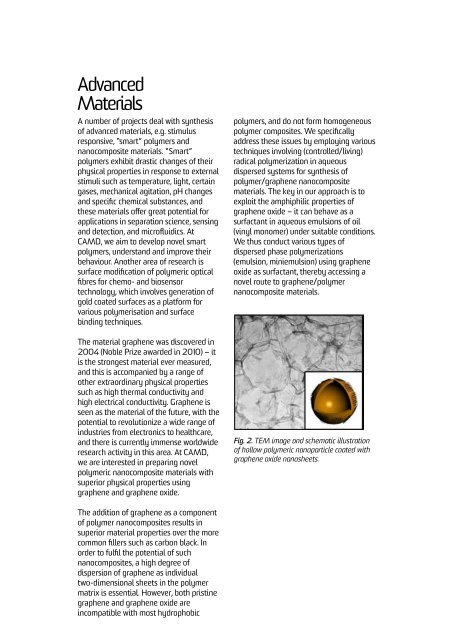CAMD_2015_Annual_Report
Create successful ePaper yourself
Turn your PDF publications into a flip-book with our unique Google optimized e-Paper software.
Advanced<br />
Materials<br />
A number of projects deal with synthesis<br />
of advanced materials, e.g. stimulus<br />
responsive, “smart” polymers and<br />
nanocomposite materials. “Smart”<br />
polymers exhibit drastic changes of their<br />
physical properties in response to external<br />
stimuli such as temperature, light, certain<br />
gases, mechanical agitation, pH changes<br />
and specific chemical substances, and<br />
these materials offer great potential for<br />
applications in separation science, sensing<br />
and detection, and microfluidics. At<br />
<strong>CAMD</strong>, we aim to develop novel smart<br />
polymers, understand and improve their<br />
behaviour. Another area of research is<br />
surface modification of polymeric optical<br />
fibres for chemo- and biosensor<br />
technology, which involves generation of<br />
gold coated surfaces as a platform for<br />
various polymerisation and surface<br />
binding techniques.<br />
The material graphene was discovered in<br />
2004 (Noble Prize awarded in 2010) – it<br />
is the strongest material ever measured,<br />
and this is accompanied by a range of<br />
other extraordinary physical properties<br />
such as high thermal conductivity and<br />
high electrical conductivity. Graphene is<br />
seen as the material of the future, with the<br />
potential to revolutionize a wide range of<br />
industries from electronics to healthcare,<br />
and there is currently immense worldwide<br />
research activity in this area. At <strong>CAMD</strong>,<br />
we are interested in preparing novel<br />
polymeric nanocomposite materials with<br />
superior physical properties using<br />
graphene and graphene oxide.<br />
polymers, and do not form homogeneous<br />
polymer composites. We specifically<br />
address these issues by employing various<br />
techniques involving (controlled/living)<br />
radical polymerization in aqueous<br />
dispersed systems for synthesis of<br />
polymer/graphene nanocomposite<br />
materials. The key in our approach is to<br />
exploit the amphiphilic properties of<br />
graphene oxide – it can behave as a<br />
surfactant in aqueous emulsions of oil<br />
(vinyl monomer) under suitable conditions.<br />
We thus conduct various types of<br />
dispersed phase polymerizations<br />
(emulsion, miniemulsion) using graphene<br />
oxide as surfactant, thereby accessing a<br />
novel route to graphene/polymer<br />
nanocomposite materials.<br />
Fig. 2. TEM image and schematic illustration<br />
of hollow polymeric nanoparticle coated with<br />
graphene oxide nanosheets.<br />
The addition of graphene as a component<br />
of polymer nanocomposites results in<br />
superior material properties over the more<br />
common fillers such as carbon black. In<br />
order to fulfil the potential of such<br />
nanocomposites, a high degree of<br />
dispersion of graphene as individual<br />
two-dimensional sheets in the polymer<br />
matrix is essential. However, both pristine<br />
graphene and graphene oxide are<br />
incompatible with most hydrophobic


